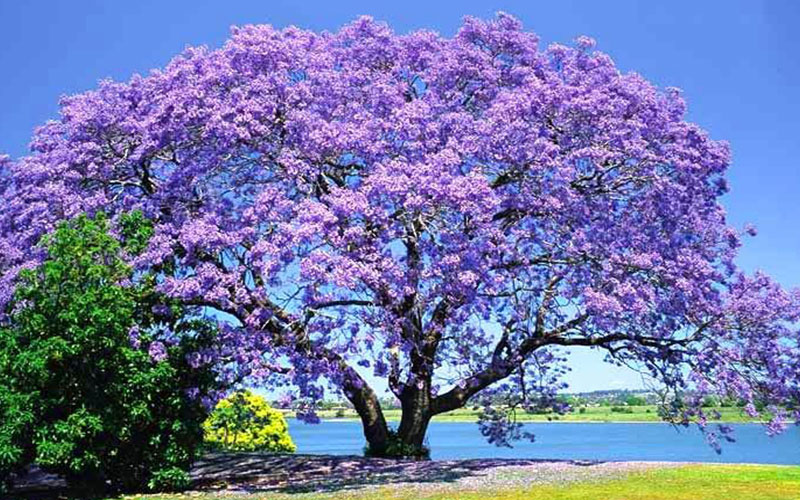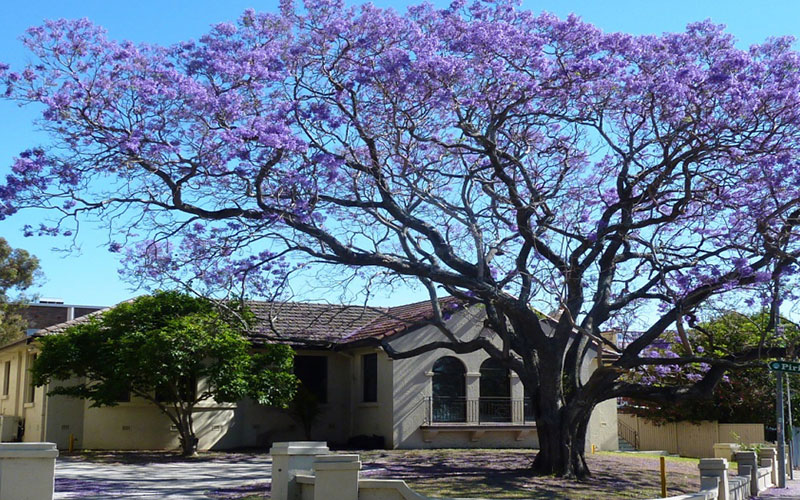Explore The JACARANDA TREE

The upright, rounded growth habit and purple-blue clusters of trumpet-shaped flowers offer notoriety to the jacaranda tree (Jacaranda mimosifolia). Its open, spreading branches and finely-texture leaves gives credence to its use in the landscape as a shade tree. Jacaranda trees require minimal, basic care in order to thrive, allowing both beginning and expert gardeners to grow it successfully.
Learn More About The JACARANDA TREE
Planting Instructions
Water and Fertilizer: Jacaranda trees require supplemental watering during periods of little to no rainfall. They also will benefit from watering when temperatures reach 95 degrees Fahrenheit or warmer. Watering frequency should be based upon soil moisture content.
Timing watering for when the top 3 to 4 inches of soil becomes dry will ensure a proper balance. Yearly applications of a 10-10-10 nitrogen, phosphorous, potassium slow-release granular fertilizer will provide the tree with needed nutrients. An application rate of 1 tablespoon per square foot of soil underneath the tree's canopy is suitable.
Timing watering for when the top 3 to 4 inches of soil becomes dry will ensure a proper balance. Yearly applications of a 10-10-10 nitrogen, phosphorous, potassium slow-release granular fertilizer will provide the tree with needed nutrients. An application rate of 1 tablespoon per square foot of soil underneath the tree's canopy is suitable.
Plant Care Tips
Pruning: Annual pruning of jacaranda trees will keep them looking clean, aesthetically pleasing and reduce growth problems. Keeping young trees pruned to a single trunk with one central leader will set the tree up for healthy mature growth. Pruning is best done in the late winter while the trees remain dormant.
Removing broken, split, cracked, damaged and diseased limbs will improve plant health while protecting nearby objects, cars and buildings from damage by falling limbs. Pruning out water sprouts, suckers, crossing or rubbing limbs and branches will crotches angles less than 45-degrees is also necessary. Removing no more than 25 percent of the tree's growth during one pruning will keep the tree's limbs and trunk from becoming burned by unblocked sunlight and will maintain regular growth rates.
Problems: Jacaranda trees have a susceptibility to aphids and mushroom root rot. Spray aphid-infested foliage with insecticidal soap, neem oil or a steady stream of water to eradicate these pests. Following proper watering practices to avoid causing overly moist soils will prevent mushroom root rot from forming.
Jacaranda trees often produce limbs with narrow crotch angles that have a high incident of splitting or breaking from the tree. Proper pruning practices to remove these problem limbs will keep the damage to a minimum. These trees drop constantly drop leaves and flowers, so locating them away from pools, streets and driveways will reduce the need for cleanup.
Removing broken, split, cracked, damaged and diseased limbs will improve plant health while protecting nearby objects, cars and buildings from damage by falling limbs. Pruning out water sprouts, suckers, crossing or rubbing limbs and branches will crotches angles less than 45-degrees is also necessary. Removing no more than 25 percent of the tree's growth during one pruning will keep the tree's limbs and trunk from becoming burned by unblocked sunlight and will maintain regular growth rates.
Problems: Jacaranda trees have a susceptibility to aphids and mushroom root rot. Spray aphid-infested foliage with insecticidal soap, neem oil or a steady stream of water to eradicate these pests. Following proper watering practices to avoid causing overly moist soils will prevent mushroom root rot from forming.
Jacaranda trees often produce limbs with narrow crotch angles that have a high incident of splitting or breaking from the tree. Proper pruning practices to remove these problem limbs will keep the damage to a minimum. These trees drop constantly drop leaves and flowers, so locating them away from pools, streets and driveways will reduce the need for cleanup.




